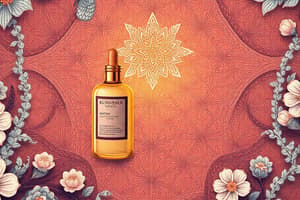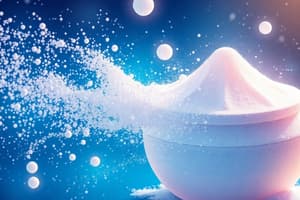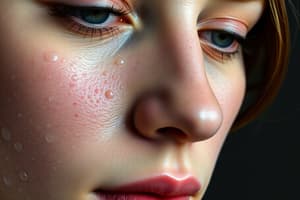Podcast
Questions and Answers
What is a key characteristic of protective agents used in topical treatments?
What is a key characteristic of protective agents used in topical treatments?
- They are chemically reactive with tissue.
- They are soluble in water to enhance absorption.
- They are biologically inactive and insoluble. (correct)
- They always provide systemic effects.
Which property of talc contributes to its effectiveness as a topical protective agent?
Which property of talc contributes to its effectiveness as a topical protective agent?
- Its layered silicate structure. (correct)
- High adsorptive properties.
- Presence of a strong odor.
- High solubility in water.
What potential risk is associated with mercury-based topical compounds?
What potential risk is associated with mercury-based topical compounds?
- They cause no systemic effects whatsoever.
- They can be toxic if absorbed in large amounts. (correct)
- They may lead to beneficial deep penetration.
- They are always safe for long-term use.
What is the primary action of antiseptics when used as topical agents?
What is the primary action of antiseptics when used as topical agents?
Which statement about talc is incorrect?
Which statement about talc is incorrect?
What is the primary reason zinc oxide appears yellow when heated to 400° or 500°C?
What is the primary reason zinc oxide appears yellow when heated to 400° or 500°C?
Which reaction represents the formation of a water-soluble product from zinc oxide?
Which reaction represents the formation of a water-soluble product from zinc oxide?
What is the variable composition range of magnesium oxide (MgO) in talc?
What is the variable composition range of magnesium oxide (MgO) in talc?
What is the role of zinc ions released from hydrolysis of zinc oxide in the skin?
What is the role of zinc ions released from hydrolysis of zinc oxide in the skin?
What is the primary ingredient in Calamine and what role does ferric oxide play?
What is the primary ingredient in Calamine and what role does ferric oxide play?
Flashcards are hidden until you start studying
Study Notes
Topical Agents
- Topical agents are applied to body surfaces and primarily act on the surface of application, though they can penetrate deeper tissues, leading to both beneficial and detrimental systemic effects.
- Types of topical agents:
- Protective agents
- Antimicrobial agents
- Astringent agents
Protective Agents
- Protectives are compounds that shield the skin from irritation, usually of mechanical origin.
- Key properties of protectives:
- Insoluble: Limits absorption through the skin, resists washing, and diminishes metallic properties on tissue.
- Chemically inert: Prevents interaction with tissue, ideal protectives are biologically inactive.
- Adsorbents: Absorb moisture from the skin's surface, lessening friction and irritation.
- Smaller particle size increases the effectiveness of protectives, as it allows for increased surface area for adhesion and moisture absorption.
- Common forms of protectives: powders, ointments, suspensions.
Talc
- Talc is a hydrous magnesium silicate often with a small amount of aluminum silicate.
- Common properties of talc:
- Fine, white to grayish white, crystalline powder
- Unctuous, adheres to the skin, and is free from grittiness.
- Softest mineral known, with a smooth, greasy feel
- Odorless, tasteless, and insoluble in water, dilute acids, and bases.
- Low adsorptive properties
- Hydrothermal method can be used to synthesize talc by reacting magnesium oxide or a magnesium salt with silica in an aqueous solution at elevated temperatures and pressures.
- Chemical formula of talc: Mg₃Si₄O₁₀(OH)₂
- Uses of talc:
- Lubricating, protective dusting powder, preventing friction and irritation.
- Cosmetic preparations (perfumed)
- Medicated preparations with antimicrobial agents, like boric acid.
Zinc Oxide
- Zinc Oxide (ZnO) is a fine, odorless, amorphous, white to yellowish white powder, devoid of gritty particles, gradually absorbing carbon dioxide from air.
- Properties of Zinc Oxide:
- Insoluble in water and alcohol.
- Reacts with dilute acids and aqueous solutions of ammonium compounds, forming water-soluble products.
- Forms zinc chloride (Lewis acid) when reacted with dilute hydrochloric acid.
- Uses of Zinc Oxide:
- Mild astringent and weak antimicrobial
- Astringent and protective in ointments, treating skin ulcerations and other dermatological problems.
- Primary ingredient in Calamine
Calamine
- Calamine is zinc oxide with a small proportion of ferric oxide, giving it a pink color.
- Properties of Calamine:
- Fine powder, odorless, practically tasteless
- Insoluble in water but soluble in mineral acids.
- Uses of Calamine:
- Topical protective
- Dusting powders, ointments, and lotions, providing soothing, absorbent, and protective properties.
Antimicrobial Agents
- Antimicrobial agents are compounds and preparations used to prevent or reduce infections caused by microorganisms.
- Terms associated with antimicrobial agents:
- Antiseptic: Kills or inhibits microorganisms growth when applied to living tissues.
- Germicide: Kills microorganisms outright, including:
- Bactericides: Kills bacteria.
- Fungicides: Kills fungi.
- Amebicides: Kills protozoa.
- -stat: Refers to agents that inhibit microbial growth without killing them (e.g., bacteriostat inhibits bacteria multiplication).
- Disinfectant: Kills microorganisms on inanimate objects but is not safe for living tissue.
- Sterilization: Completely removes or kills all microorganisms from an object, rendering it sterile.
- Mechanisms of action of inorganic antimicrobial agents:
- Oxidation: Compounds that are generally nonmetals and certain types of anions. The most common examples include:
- Hydrogen peroxide
- Metal peroxides
- Permanganates
- Halogens (chlorine and iodine)
- Oxo-halogen anions
- Halogenation:
- Protein Precipitation:
- Oxidation: Compounds that are generally nonmetals and certain types of anions. The most common examples include:
Sodium Hypochlorite
- Sodium hypochlorite solutions are strong oxidizing agents. When reacted with water, it forms hypochlorous acid: NaOCl + H2O ⟶ HOCl + NaOH.
- Uses of Sodium Hypochlorite Solutions:
- Disinfectant
- Laundry bleach
- Antiseptic on pus-forming wounds (historically, but not preferred due to its potential to dissolve sutures and blood clots)
- Foot bath for prevention of fungal infections (e.g., athlete's foot)
- Diluted Sodium Hypochlorite Solution (N.F.XIII):
- Reduced caustic action on tissues by reducing pH with sodium bicarbonate solution.
- Increases the effective concentration of hypochlorous acid.
- Antibacterial effectiveness is potentially increased by acidifying the solution.
Iodine Solution
- Iodine Solution and Iodine Tincture contain the same concentrations of ingredients, but differ in their solvents: Iodine Solution is aqueous (water), and Iodine Tincture contains alcohol.
- Both solutions are transparent and reddish-brown, with the characteristic odor of iodine.
- Iodine Tincture also has the odor of alcohol.
- Antimicrobial Agent: Iodine
- Chemical property in solution: Mild oxidizing agent through the formation of hypoiodous acid [HIO].
- Uses of Iodine Solution and Tincture:
- Used as antiseptics
- Used to treat minor wounds or infections due to their broad-spectrum antimicrobial activity
Silver Nitrate
- Chemical property: Silver ion (Ag⁺) is a strong protein precipitant, acting on both bacterial and human proteins.
- Uses of Silver Nitrate:
- Antibacterial in solutions ranging from 0.01 to 10%, with higher concentrations showing astringent and irritant properties.
- Silver Nitrate Ophthalmic Solution (1%): Instilled into the eyes of newborns as a prophylactic measure against gonococcal infections (ophthalmia neonatorum).
- 0.5% aqueous solution as a wet dressing on third-degree burns.
- Side effect: Prolonged use can cause argyria, a darkening of the skin due to silver deposition under the epidermis, and is generally irreversible.
Astringent Agents
- Astringents cause protein precipitation on the surface of cells, coagulating proteins and constricting tissue without causing deep damage.
- Mechanism: Act on smooth muscle in small blood vessels.
- Uses of Astringents:
- Styptic action: Stop bleeding from small cuts by promoting blood coagulation and constricting capillaries.
- Antiperspirant: Decrease sweat secretion.
- Constrict mucous membranes: Reduce inflammation by limiting blood flow to the surface.
Studying That Suits You
Use AI to generate personalized quizzes and flashcards to suit your learning preferences.




